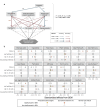Effects of management practices on the ecosystem-service multifunctionality of temperate grasslands
- PMID: 38714701
- PMCID: PMC11076620
- DOI: 10.1038/s41467-024-48049-y
Effects of management practices on the ecosystem-service multifunctionality of temperate grasslands
Abstract
Human wellbeing depends on ecosystem services, highlighting the need for improving the ecosystem-service multifunctionality of food and feed production systems. We study Swiss agricultural grasslands to assess how employing and combining three widespread aspects of grassland management and their interactions can enhance 22 plot-level ecosystem service indicators, as well as ecosystem-service multifunctionality. The three management aspects we assess are i) organic production system, ii) an eco-scheme prescribing extensive management (without fertilization), and iii) harvest type (pasture vs. meadow). While organic production system and interactions between the three management aspects play a minor role, the main effects of eco-scheme and harvest type considerably shape single services. Moreover, the eco-scheme 'extensive management' and the harvest type 'pasture' enhance plot-scale ecosystem-service multifunctionality, mostly through facilitating cultural services at the expense of provisioning services. These changes in ecosystem-service supply occur mainly via changes in land-use intensity, i.e., reduced fertilizer input and harvest frequency. In conclusion, diversifying grassland management where this is currently homogeneous across farms and landscapes depicts an important first step to improve landscape-scale multifunctionality for sustainable grassland systems. To meet societal ecosystem services demand, the three studied management aspects can be systematically combined to increase ecosystem services that are in short supply.
© 2024. The Author(s).
Conflict of interest statement
The authors declare no competing interests.
Figures





References
-
- Swinton SM, Lupi F, Robertson GP, Hamilton SK. Ecosystem services and agriculture: cultivating agricultural ecosystems for diverse benefits. Ecol. Econ. 2007;64:245–252. doi: 10.1016/j.ecolecon.2007.09.020. - DOI
-
- White, R. P., Murray, S. & Rohweder, M. Pilot Analysis of Global Ecosystems—Grassland Ecosystems (World Resources Institute, Washington D.C., 2000).
-
- Roser, M., Ritchie, H. & Rosado, P. Food supply. OurWorldInData.org. Retrieved from: https://ourworldindata.org/food-supply (2013).
Publication types
MeSH terms
Substances
Grants and funding
LinkOut - more resources
Full Text Sources

